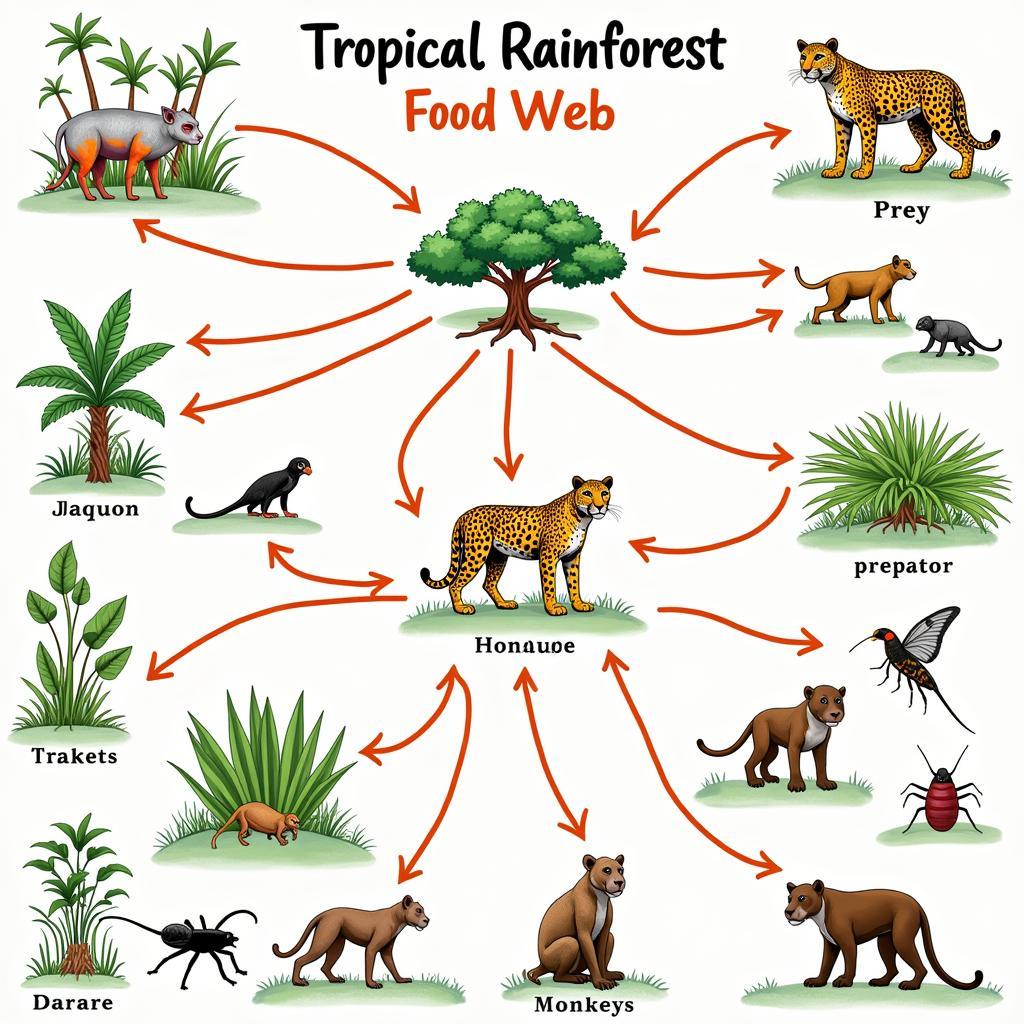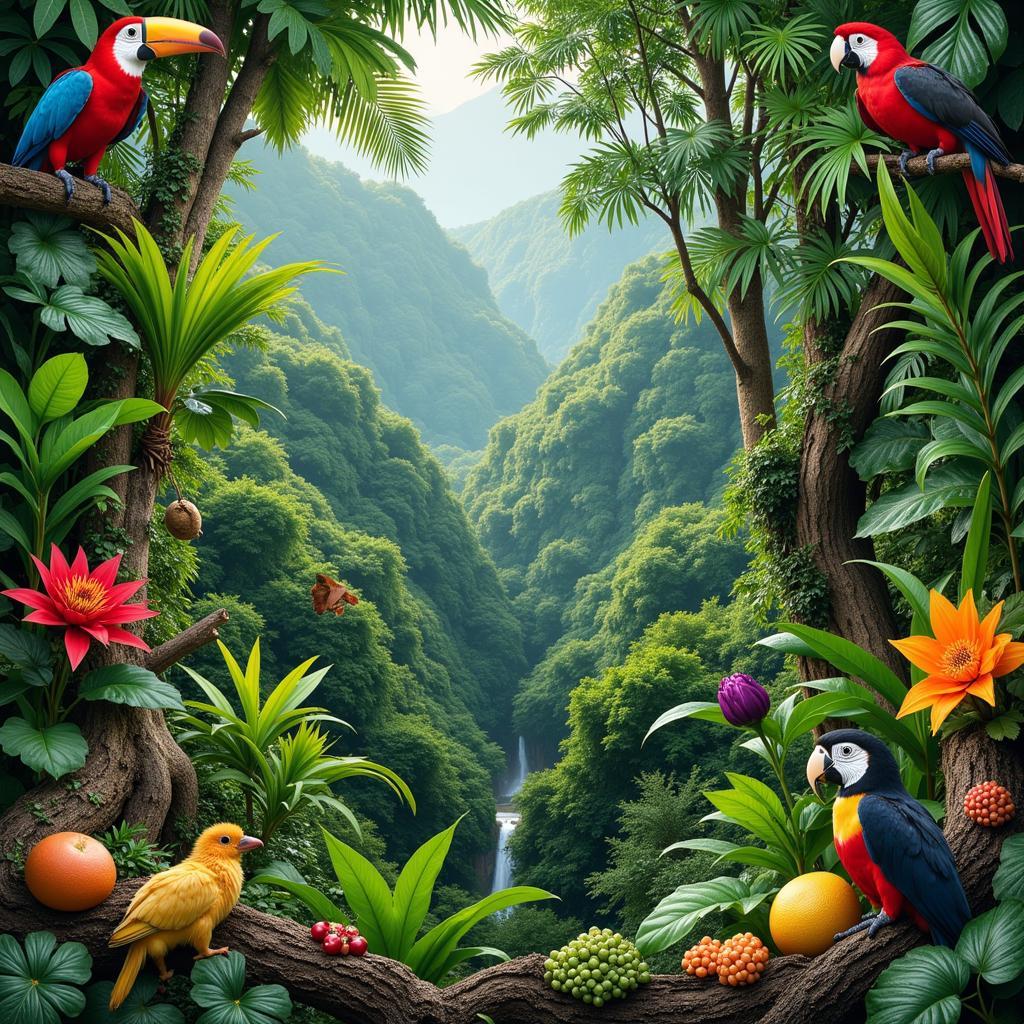The vibrant tapestry of life in a tropical forest biome is woven together by a complex and fascinating network of interactions, none more crucial than the Tropical Forest Biome Food Web. This intricate system of energy flow dictates the survival of countless species, from the towering trees to the tiniest insects. Join us as we delve into the fascinating world of the tropical rainforest food web and discover the delicate balance that sustains this incredible ecosystem.
A Feast for the Senses: Unpacking the Tropical Forest Food Web
Imagine a world teeming with life, where every creature plays a vital role in the delicate balance of nature. That’s the essence of a tropical forest biome food web. It all starts with the sun, the ultimate source of energy. Plants, the primary producers, harness this energy through photosynthesis, converting sunlight into food. From here, the energy flows through the ecosystem in a complex web of predator-prey relationships.
 Tropical Rainforest Food Web Diagram
Tropical Rainforest Food Web Diagram
Levels of Life: Navigating the Food Chain Hierarchy
The tropical forest food web is typically categorized into different trophic levels, each representing a link in the chain of energy transfer:
- Producers: Plants, algae, and some bacteria form the backbone of the food web, using sunlight to create their own food through photosynthesis.
- Primary Consumers: Herbivores like sloths, monkeys, and fruit-eating birds feast on the abundant plant life, obtaining energy directly from the producers.
- Secondary Consumers: Carnivores such as snakes, frogs, and some insects, prey on the herbivores, taking in the energy that the herbivores originally derived from plants.
- Tertiary Consumers: At the top of the food chain sit apex predators like jaguars, eagles, and large snakes. They feast on both primary and secondary consumers, commanding the rainforest’s energy flow.
Intricate Connections: Beyond the Simple Chain
While the trophic levels provide a basic framework, the reality of the tropical forest biome food web is far more intricate. Organisms often participate in multiple food chains, creating a complex web of interconnected relationships. For instance, a monkey might consume fruits, making it a primary consumer. But it might also eat insects occasionally, pushing it into the role of a secondary consumer.
This interconnectedness makes the ecosystem incredibly resilient. If one species declines, others can often fill the gap, preventing a catastrophic collapse of the entire web.
A Delicate Balance: Threats to the Tropical Forest Food Web
Despite its resilience, the tropical forest biome food web is under constant threat, primarily from human activities. Deforestation, habitat fragmentation, and climate change are disrupting the delicate balance of these ecosystems. As we lose biodiversity, the intricate connections within the food web weaken, making the entire system more vulnerable to collapse.
Preserving Paradise: Protecting the Tropical Forest Food Web
Protecting this intricate web of life is not just an ecological imperative, it’s crucial for the health of our planet. By supporting sustainable practices, advocating for conservation efforts, and raising awareness about the importance of biodiversity, we can all contribute to the preservation of this incredible ecosystem.
FAQs About Tropical Forest Biome Food Webs
-
What is the role of decomposers in the food web?
Decomposers like fungi and bacteria break down dead plants and animals, returning essential nutrients to the soil. This process nourishes the producers, completing the cycle of life. -
How does deforestation impact the food web?
Deforestation eliminates habitat and food sources for countless species, disrupting the delicate balance of the food web and leading to a decline in biodiversity. -
Can you give an example of a food chain in the tropical rainforest?
Sun → Fig Tree → Monkey → Jaguar -
Why are tropical rainforests considered biodiversity hotspots?
Tropical rainforests boast a remarkable variety of species due to their stable climate and abundant resources, leading to complex and diverse food webs. -
What can I do to help protect tropical rainforests?
Support sustainable practices, reduce your carbon footprint, educate others, and consider donating to organizations working to conserve these precious ecosystems.
 Diverse Species in Tropical Rainforest
Diverse Species in Tropical Rainforest
Need Help Navigating the Jungle of Information?
For more insights and assistance, contact us at Phone Number: 02437655121, Email: minacones@gmail.com or visit us at 3PGH+8R9, ĐT70A, thôn Trung, Bắc Từ Liêm, Hà Nội, Việt Nam. Our dedicated team is available 24/7 to guide you.